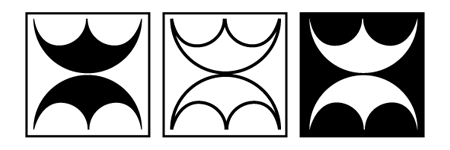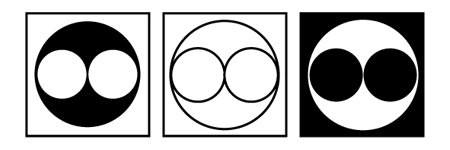Filler motifs featuring two back-to back peltae appear relatively often (Fig. 45).
 |
As with other geometric decorations (e.g. cruciforms, Solomon’s knots, four-pointed stars etc.) it usually serves to decorate square-shaped fields. The peltae’s external curves are very close and separated by nothing more than a background row of small stones. Their width is determined by the side length of the framing squares. Their handles point towards the outer corners.
The motif appears three times in diamond patterns. On a mosaic from Chios black peltae appear on a white background. For the remaining filler motifs on the floor (plaited bands, diamonds, circle segments etc.) red, yellow and grey tessellae were also used. The two other pavements from Skala and Olympia also possess rich polychrome. However, here the peltae are blank white upon a dark background. Clearly a classic black-and-white contrast was chosen for the peltae decoration.
Only on a pavement in Samos were pairs of light brown peltae set against a white background. In this instance the motif decorates the larger fields of a square-shaped pattern.
Back-to-back peltae appear within a chessboard pattern on a mosaic in Thessaloniki. They are blank white and arranged alternatively lying or standing. In every second square a Solomon’s knot appears as a contour drawing, like the peltae themselves. The chessboard pattern is surrounded by a black-and-white wavy band and a black stripe. It forms a clear contrast to the rich polychrome of the remaining parts of the mosaic. In Patras a concentric mosaic surface is surrounded by a broad border consisting of squares in a row. In each square is a small motif. In addition to bucrania, kantharoi, rosettes and stars, peltae also appear. The colours of the pavement are unknown, as up to now only a miniaturised drawing has been published.
In Amphipolis two polychrome image fields surrounded by a black-and-white swastika meander pattern with enclosed squares were found. Within the squares white cruciforms on a black background alternate with pelta pairs on a white background. The black-and-white meander frame has the effect of a calming pole between the polychrome, three-stranded plaited band of the image fields and the external cruciform pattern. Again here the preferred style of pelta decoration was black-and-white. This is also the case for a motif that appears less frequently in Greece, the so-called double pelta, which consists of two peltae whose tips touch. At first glance it looks like a circle containing two smaller circles (Fig. 46).
 |
Double peltae usually appear in smaller areas of surface patterns. In Olympia a white double pelta decorates the square of a diamond-star pattern. On a mosaic in Argos blank white double peltae appear in the diamonds of a meander or Greek key-pattern. The colour of a further mosaic from Argos is unclear as only a technical drawing of the design is available. In this case a double pelta can be found in the diamond-shaped field at the edge of the pavement (Catalogue 9, Room E).